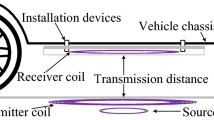Abstract
The analysis of a two-coil wireless power transfer (WPT) system can be done in different forms including using two-port network representations. Here, we opt to use a transmission matrix-based model and revert to symbolic math analysis CAD tools to derive closed form expressions (without any simplifying assumptions) for the complex power supplied by the system with and without an input compensation capacitor. The important role played by this capacitor in minimizing the re-active power loss is demonstrated and numerical simulations using typical values from two WPT systems are provided.



Similar content being viewed by others
References
S. Akbar, I. Hodaka, A design approach to wireless high-power transfer to multiple receivers, with asymmetric circuits. Circuits Syst. Signal Process. 15, 125–134 (2021). https://doi.org/10.46300/9106.2021.15.14
P.K. Chittoor, B. Chokkalingam, L. Mihet-Popa, A review on uav wireless charging: fundamentals, applications, charging techniques and standards. IEEE Access 9, 69235–69266 (2021). https://doi.org/10.1109/ACCESS.2021.3077041
C. Degen, Inductive coupling for wireless power transfer and near-field communication. EURASIP J. Wirel. Commun. Netw. 2021(1), 121 (2021). https://doi.org/10.1186/s13638-021-01994-4
A.S. Elwakil, B.J. Maundy, Calculating output impedance in linear networks without source nulling or load disconnect: the instantaneous output impedance. Int. J. Circuit Theory Appl. 44(1), 98–108 (2016)
S.B. Glybovski, S.A. Tretyakov, P.A. Belov et al., Metasurfaces: from microwaves to visible. Phys. Rep. 634, 1–72 (2016)
S.Y.R. Hui, W. Zhong, C.K. Lee, A critical review of recent progress in mid-range wireless power transfer. IEEE Trans. Power Electron. 29(9), 4500–4511 (2013)
F. Issi, O. Kaplan, Design and application of wireless power transfer using Class-E inverter based on adaptive impedance-matching network. ISA Trans. (2021). https://doi.org/10.1016/j.isatra.2021.07.050
C. Jiang, K.T. Chau, C. Liu et al., An overview of resonant circuits for wireless power transfer. Energies 10(7), 5 (2017). https://doi.org/10.3390/en10070894
Y. Jiang, L. Wang, Y. Wang et al., Phase-locked loop combined with chained trigger mode used for impedance matching in wireless high power transfer. IEEE Trans. Power Electron. 35(4), 4272–4285 (2020). https://doi.org/10.1109/TPEL.2019.2936708
M. Lu, M. Bagheri, A.P. James et al., Wireless charging techniques for uavs: a review, reconceptualization, and extension. IEEE Access 6, 29865–29884 (2018). https://doi.org/10.1109/ACCESS.2018.2841376
M. Machnoor, G. Lazzi, Wireless power transfer: types of reflected impedances and maximum power transfer theorem. IEEE Antennas Wirel. Propag. Lett. 19(10), 1709–1713 (2020). https://doi.org/10.1109/LAWP.2020.3014357
B.J. Maundy, A. Elwakil, A. Al-Ali, et al., Synthesis and analysis of fully differential filters using two port networks, in 2017 IEEE 60th International Midwest Symposium on Circuits and Systems (MWSCAS), pp. 1105–1108. https://doi.org/10.1109/MWSCAS.2017.8053121 (2017)
N. Mourad, A. Azuwa, M. Najib et al., A comprehensive review of midrange wireless power transfer using dielectric resonators. Int. J. Antennas Propag. 5493, 013 (2021). https://doi.org/10.1155/2021/5493013
D.W. Seo, J.H. Lee, H.S. Lee, Study on two-coil and four-coil wireless power transfer systems using z-parameter approach. ETRI J. 38(3), 568–578 (2016)
S. Shahsavari, M. Saberi, A power-efficient cmos active rectifier with circuit delay compensation for wireless power transfer systems. Circuits Syst. Signal Process. 38(3), 947–966 (2019). https://doi.org/10.1007/s00034-018-0902-9
M. Song, P. Jayathurathnage, E. Zanganeh et al., Wireless power transfer based on novel physical concepts. Nat. Electron. 4(10), 707–716 (2021). https://doi.org/10.1038/s41928-021-00658-x
H. Zhou, B. Zhu, W. Hu et al., Modelling and practical implementation of 2-coil wireless power transfer systems. J. Electr. Comput. Eng. 2014, 1–8 (2014)
Author information
Authors and Affiliations
Corresponding author
Additional information
Publisher's Note
Springer Nature remains neutral with regard to jurisdictional claims in published maps and institutional affiliations.
Rights and permissions
Springer Nature or its licensor holds exclusive rights to this article under a publishing agreement with the author(s) or other rightsholder(s); author self-archiving of the accepted manuscript version of this article is solely governed by the terms of such publishing agreement and applicable law.
About this article
Cite this article
Elwakil, A., Maundy, B. & Allagui, A. A Note on the Analysis of Two-Coil Wireless Power Transfer Systems. Circuits Syst Signal Process 42, 1808–1817 (2023). https://doi.org/10.1007/s00034-022-02165-6
Received:
Revised:
Accepted:
Published:
Issue Date:
DOI: https://doi.org/10.1007/s00034-022-02165-6




